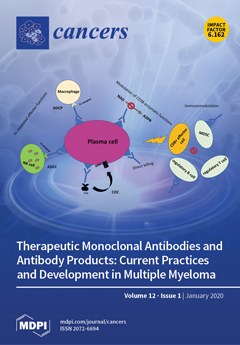Background: The prognostic impact of the expression profile of genes recurrently amplified in glioblastoma multiforme (GBM) remains controversial. Methods: We investigated the RNA gene expression profile of epidermal growth factor receptor (
EGFR), cyclin-dependent kinase 4 (
CDK4), murine doble minute
[...] Read more.
Background: The prognostic impact of the expression profile of genes recurrently amplified in glioblastoma multiforme (GBM) remains controversial. Methods: We investigated the RNA gene expression profile of epidermal growth factor receptor (
EGFR), cyclin-dependent kinase 4 (
CDK4), murine doble minute 4 (
MDM4), and platelet derived growth factor receptor alpha (
PDGFRA) in 83 primary GBM tumors vs. 42 normal brain tissue samples. Interphase FISH (iFISH) analysis for the four genes, together with analysis of intragenic deletions in
EGFR and
PDGFRA, were evaluated in parallel at the DNA level. As validation cohort, publicly available RNA gene expression data on 293 samples from 10 different GBM patient series were also studied. Results: At the RNA level,
CDK4 was the most frequently overexpressed gene (90%) followed by
EGFR (58%) and
PDGFRA (58%). Chromosome 7 copy number alterations, i.e., trisomy (49%) and polysomy (44%), showed no clear association with
EGFR gene expression levels. In turn, intragenic
EGFR deletions were found in 39 patients (47%), including
EGFRvIII (46%) in association with
EGFRvIVa (4%),
EGFRvII (2%) or other
EGFR deletions (3%) and
PDGFRA deletion of exons 8–9 was found in only two tumors (2%). Conclusions: Overall, none of the gene expression profiles and/or intragenic
EGFR deletions showed a significant impact on overall survival of GBM supporting the notion that other still unraveled features of the disease might play a more relevant prognostic role in GBM.
Full article






